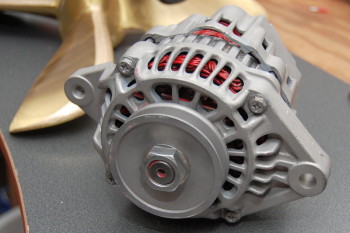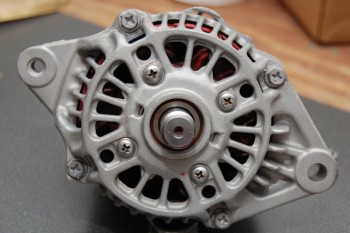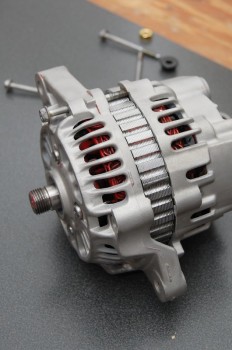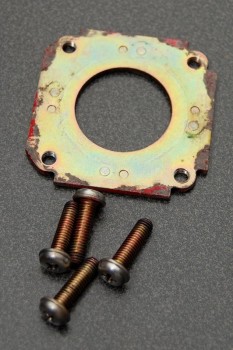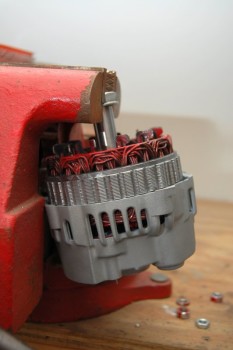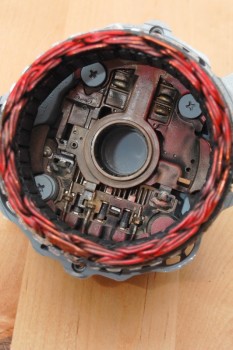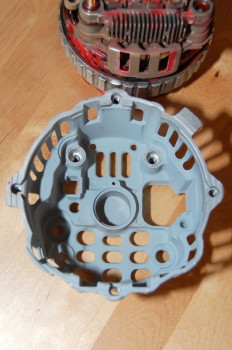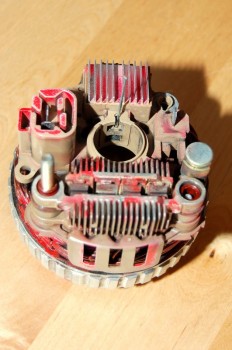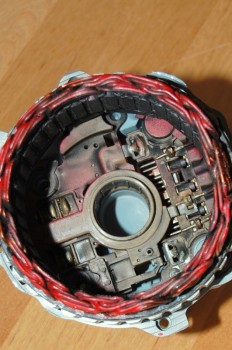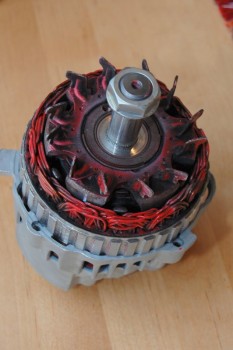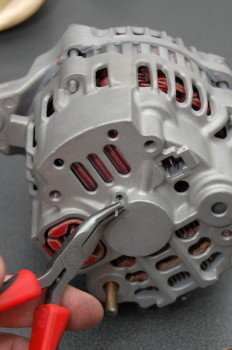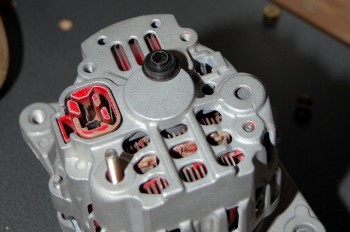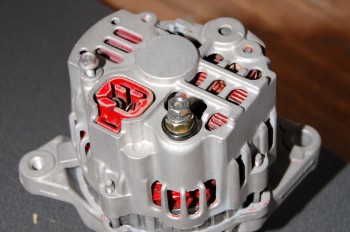Remove The Pulley
This article takes a look inside a typical Mitsibishi/Westerbeke 50A alternator. These are tiny little work horses that can suitably handle charging small battery banks. An alternator like this is not designed to charge massive house banks but if you day sail and are most often tied to a dock with shore power they can last for a few thousand engine hours.
The first step is to remove the pulley. The easiest way to remove any alternator pulley is to use impact driver to do this. If you don’t have an impact driver bring it by any garage and a mechanic will probably zip it of for free.
Remove Bolts
To split or open the case remove the four bolts closest to the edges of the alternator. Once the case is split remove the four machine screws closest to the pulley as these hold the front bearing retainer plate.
Case Bolts
These are the bolts that hold the front and back alternator case together.
Front Bearing
The front bearing is the only part in this alternator that actually needed replacing but I replaced the rear bearing as well.
The Westerbeke engine this alternator came off had approx 2800 hours on its clock and this alternator was still in near perfect working condition. This alternator had been charging a small house bank consisting of a single group 31 battery, pretty easy work even for a stock alternator.
If you are wondering why this alternator is so clean it’s because I cheated and bead blasted it. I had already taken it apart but forgot to photograph it before I blasted it.
Bearing Retainer
This is the plate that retains the front bearing. To replace the bearing simply remove this plate, press the old one out and order a new one. It takes all of two minutes to replace the front bearing on this particular alternator.
Removing the Rotor
This is where it can become slightly tricky. On this Mitsubishi built alternator the rear bearing is simply a light press fit into the rear case. To remove the rotor I just placed the shaft in the vice, being careful to only grab the shaft nut, and then lightly tapped the case with my lead hammer while rotating it so it came off evenly. I would not use a regular iron hammer to tap on aluminum but it’s up to you.
Remember this is light tapping, not pounding. Be very careful when tapping the case and removing the rotor as you do not want to damage anything. Many of these small case internal fan alternators are assembled in a similar fashion.
Another method is to heat the rear case, close to & surrounding the rear bearing, with a heat gun. This will expand the aluminum and allow the bearing to slide out.
Remove the Three Gray Screws
Once the rotor is out all you need to do on this one is remove the three gray screws and pull the stator assembly out.
On this unit the brush holder, voltage regulator and stator come out as one unit and like all alternators stator is soldered diode rack and on this one also to the regulator/brush holder assembly.
If you are wondering where the brushes are, they have been retracted and held back inside the housing for re-assembly. You’ll see how a bit later.
IMPORTANT: Please resist the urge to spray paint your alternator as Westerbeke did on this motor. The red paint on the stator winding’s causes excess heat build up and impacts proper cooling. If the paint is actually thick enough the alternator can physically burn itself up. This alternator is charging a small bank so it’s not a huge deal killer. The stator winding’s should look like bare copper wire with a clear coat paint applied.
Rear Case
In this photo you’ll notice a tiny hole right next to the center bearing location at the 12:00 position. This is the hole which you use to retain the brushes while installing the rotor. You can’t install the rotor with the brushes in the way, so the brushes must be held back adn kept out of the way.
The brushes on this alternator were still in great condition with plenty of length left.
Stator, Diodes & Voltage Regulator Assembly
In this photo you’ll notice a 2″ long brad nail stuck into a tiny hole next to the brushes. This is how you retain the brushes in order to install the rotor. I find a brad nail to be the perfect tool to retain these brushes.
Unfortunately with many of these dual internal fan Japanese style alternators the voltage regulator, diodes and brush assembly are all one unit. The voltage assembly is also soldered directly to the stator a standard practice. While not hard to replace it is more of a pain than types of alternators.
Fortunately this one was still operating flawlessly so no need for replacement.. I’m sure it will run a bit cooler now that I cleaned all the dust and grime out of it too.
The Rotor
From the left you’ll notice the rear bearing & then the copper colored brush contacts which are called slip-rings. There are dual fans on either side of the rotor that are internal to this alternator. Try to keep the fins clean, these had been filthy, and it will result in much better cooling.
Re-Assembly
The first step with an alternator like this one is to retain the brushes, as you saw above. You then line up, and slide, the stator/regulator assembly back into the rear case being very careful to make the brush retaining brad nail slide into the small hole in the rear case.
Sometimes a Sharpie marker is a good way to mark both the stator and the case so you know how they line up & go back together.
Don’t forget to re-install the three gray screws before installing the rotor, or what ever holds your stator/regulator/diode assembly in place.
Install The Rotor
In this picture the rotor is set into the case but has not yet been seated into the rear bearing cavity.
To seat this bearing I simply flipped it upside down, with shaft nut against my work bench, then tapped it with my fist and gave it one light tap with the lead mallet. Simple..
Pull Out The Brad Nail
Remember when I showed you the tiny hole in the rear case? This is how it works.
Install the rotor and put the case back together, then pull out the brad nail or what ever you used to retain the brushes.
Output Post Insulator
The black plastic ring shown here is to insulate the alternators 12V B+ output stud from the grounded alternator case. Do not forget to reinstall this insulator or you could have a direct short to ground once the alt is connected to the battery bank.
Ground Screw & B+ Output Stud
In this image I have reinstalled the B+ insulator, ground screw and the retaining bolts for the 12V output stud so the back end of the alternator is done.
All Done
The lasts step is to replace the pulley and for this task an impact driver was used.
While this alternator did not require a full “rebuild“, and all it needed was bearings, taking it apart, cleaning it and inspecting the brushes, bearings etc. is never a bad idea.
With the front & rear bearings replaced, the internals cleaned, and the case bead blasted and put back together she is ready for another 2800 more hours.
While an alternator like this can survive for quite a long time charging a small bank, they will not survive charging massive house banks. The calls I normally get for alternators like this are EOL calls (end of life) because they have literally cooked themselves. Once they cook there is no sense in even repairing them and it is best to opt for a higher performance alternator and regulator system. When trying to charge massive banks not only will the alternator suffer but so will the batteries. Alternators like this reduce regulation voltage as alternator temperature increases. This winds up chronically undercharging large banks and we get stuck in a Catch 22..
TIP: If you want to paint the alternator case please do so before putting it back together. Only paint the exterior parts of the case so you don’t impact the ability of the aluminum to dissipate heat.
This is not a difficult job and most any local alternator shop should be able order you the parts you need. I got my front & rear bearings from a local auto bearing shop here in Maine for about $12.00..
If your alternator needs diodes, a regulator, stator or has other more serious issues I recommend finding a competent auto electric shop and have them complete those tasks.
Good luck & happy boating!

